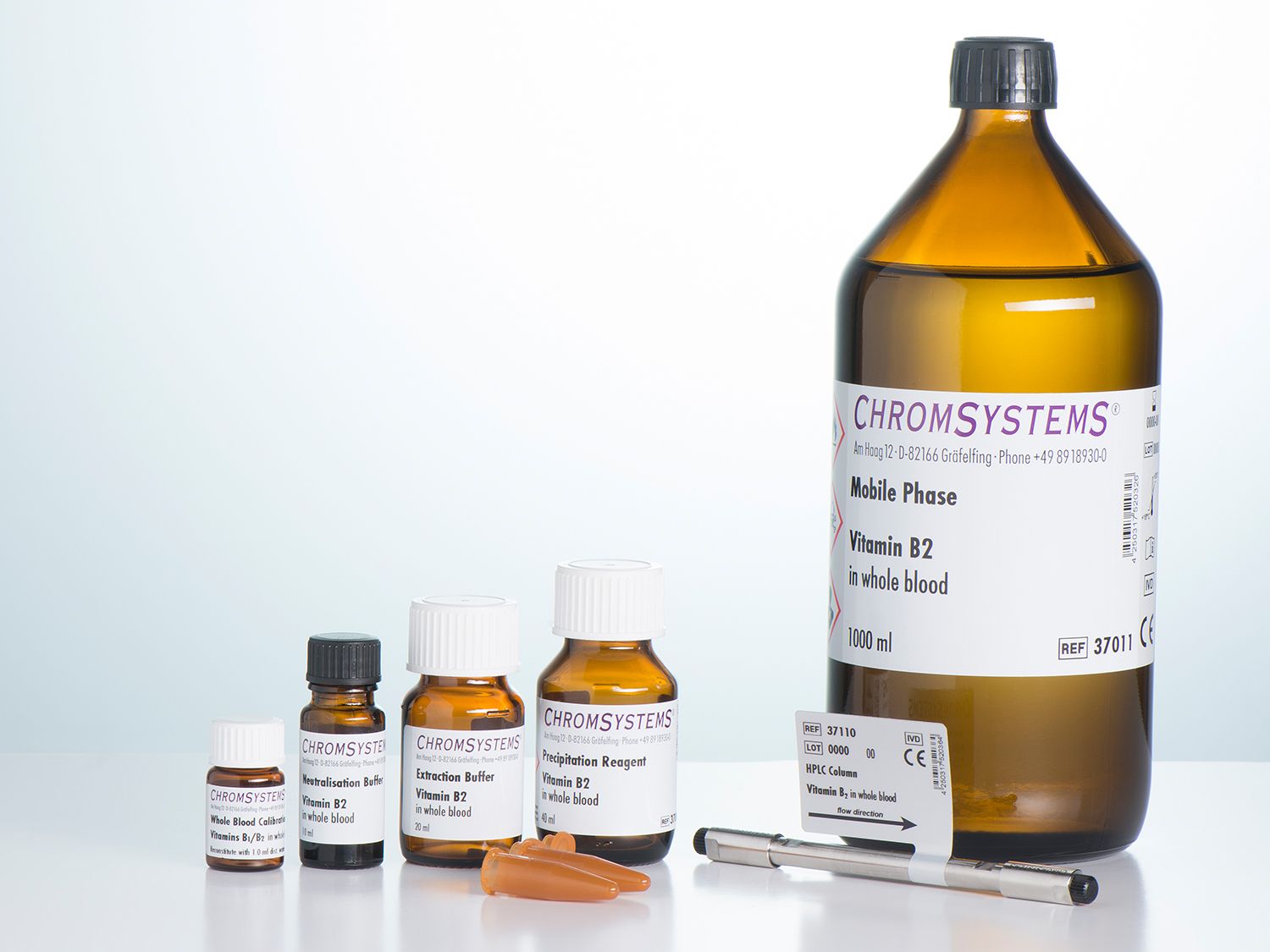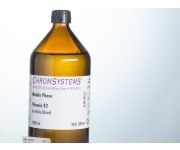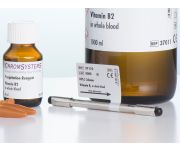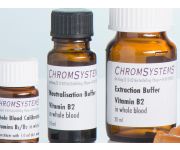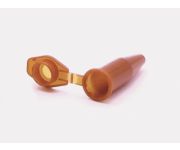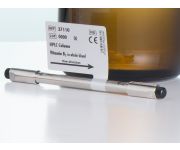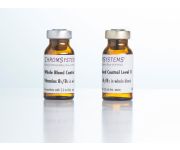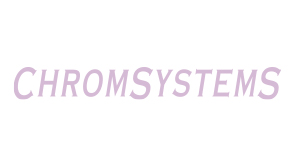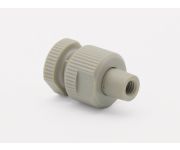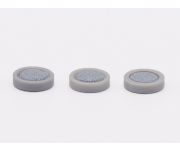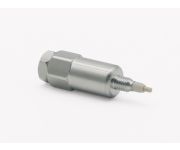Vitamin B2 in Whole Blood - HPLC
Safe results by stabilisation of FAD
Simultaneous determination of FMN
Highly stable calibrators and controls
CE-IVD validated product ready for IVDR within timeframes and transition periods specified by the IVDR 2017/746
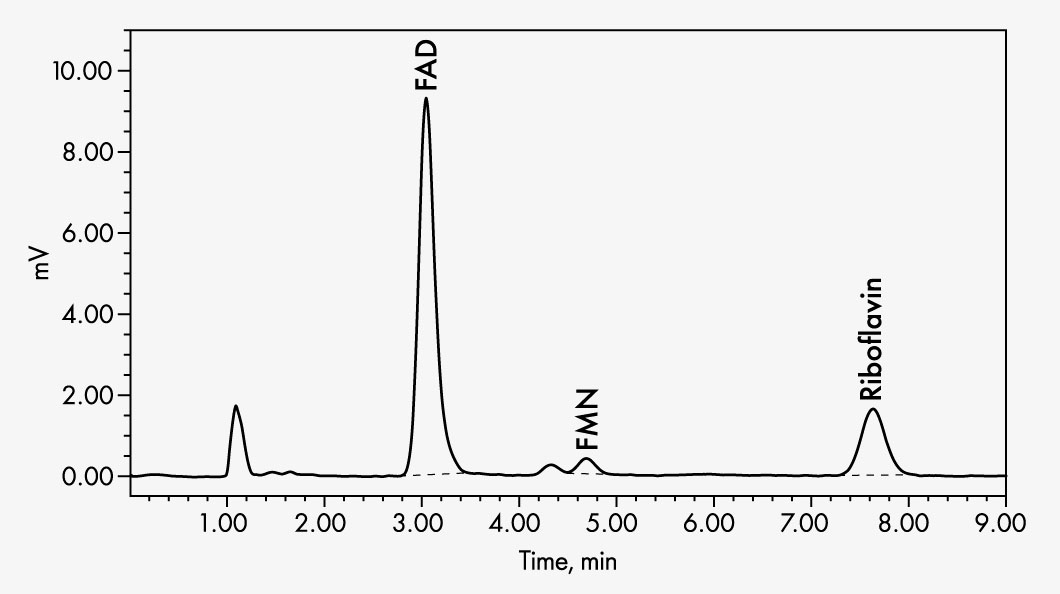

Flavin adenine dinucleotide (FAD)
Flavin mononucleotide (FMN), Vitamin B2 (Riboflavin)
Clinical relevance
Vitamin B2 (riboflavin) belongs to the vitamin B complex, a heterogeneous group of water-soluble vitamins that are all precursors of coenzymes. The coenzymes flavin adenine dinucleotide (FAD) and flavin mononucleotide (FMN) are derived from riboflavin. In their capacity as a prosthetic group in flavoenzymes, they are responsible for the transfer of hydrogen in the respiratory chain. They also play a role in the metabolism of carbohydrates, fatty acids, and amino acids. In addition to its influence on other vitamins such as vitamin B6, riboflavin is essential for maintaining the glutathione reductase activity, thereby having an indirect antioxidative effect.
In Western Europe, a deficiency of riboflavin is observed particularly with vegans, smokers, diabetics and as a result of excessive consumption of alcohol. Typical signs of a vitamin B2 deficiency are poorly healing cracks at the corners of the mouth, inflammation of the oral mucosa and tongue, conjunctivitis and skin inflammation. A severe vitamin B2 deficiency may also promote the development of cataracts.
Product advantages
- Reliable measurement results due to stabilisation of FAD
- Simultaneous determination of riboflavin, FMN and FAD
- Stable calibrators and controls
The present method developed by Chromsystems allows for the fast, simple and specific determination of riboflavin and its active metabolites FAD and FMN in whole blood using an isocratic HPLC system. Due to their native fluorescence, the analytes can be detected directly, without derivatisation. Sample preparation requires only one effective protein precipitation step and subsequent stabilisation of the analytes. A special HPLC column and an optimised mobile phase enable precise and reliable quantification of the analytes.
| Method of Analysis | HPLC |
|---|---|
| Number of Tests | 100 |
| Please note | The freely available information on this website, in particular on the sample preparation, are not sufficient to work with our products. Please read instructions and warning notices on products and/or instruction manuals. |
| Lower Limit of Quantitation | FAD 3 µg/l |
| Upper Limit of Quantification | FAD up to 1000 µg/l |
| Intraassay | CV < 3 % |
| Interassay | CV < 5.9 % |
| Recovery | FAD 106 %, FMN 100 %, Rivoflavin 108 % |
| Specimen | Whole Blood |
| Sample Preparation |
|
| Run Time | aproxx. 9 min |
| Injection Volume | 50 µl |
| Flow Rate | 1.2 ml/min |
| Column Temperature | ambient (~ 20 °C) |
| Gradient | isocratic |
| Wavelengths | EX 465 nm EM 525 nm |
| Additional Info | Every isocratic HPLC system with fluorescence detector is suitable. |
| Parameters | Flavin adenine dinucleotide (FAD), Flavin mononucleotide (FMN), Vitamin B2 (Riboflavin) |
-
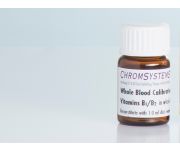 Whole Blood Calibration Standard Vitamins B1/B2Order no.: 37008Vitamin B1/B2 in Whole Blood - HPLC
Whole Blood Calibration Standard Vitamins B1/B2Order no.: 37008Vitamin B1/B2 in Whole Blood - HPLC
-
 Whole Blood Calibration Standard Vitamins B1/B2Order no.: 37008Vitamin B1/B2 in Whole Blood - HPLC
Whole Blood Calibration Standard Vitamins B1/B2Order no.: 37008Vitamin B1/B2 in Whole Blood - HPLC


Flavin adenine dinucleotide (FAD)
Flavin mononucleotide (FMN), Vitamin B2 (Riboflavin)
Clinical relevance
Vitamin B2 (riboflavin) belongs to the vitamin B complex, a heterogeneous group of water-soluble vitamins that are all precursors of coenzymes. The coenzymes flavin adenine dinucleotide (FAD) and flavin mononucleotide (FMN) are derived from riboflavin. In their capacity as a prosthetic group in flavoenzymes, they are responsible for the transfer of hydrogen in the respiratory chain. They also play a role in the metabolism of carbohydrates, fatty acids, and amino acids. In addition to its influence on other vitamins such as vitamin B6, riboflavin is essential for maintaining the glutathione reductase activity, thereby having an indirect antioxidative effect.
In Western Europe, a deficiency of riboflavin is observed particularly with vegans, smokers, diabetics and as a result of excessive consumption of alcohol. Typical signs of a vitamin B2 deficiency are poorly healing cracks at the corners of the mouth, inflammation of the oral mucosa and tongue, conjunctivitis and skin inflammation. A severe vitamin B2 deficiency may also promote the development of cataracts.
Product advantages
- Reliable measurement results due to stabilisation of FAD
- Simultaneous determination of riboflavin, FMN and FAD
- Stable calibrators and controls
The present method developed by Chromsystems allows for the fast, simple and specific determination of riboflavin and its active metabolites FAD and FMN in whole blood using an isocratic HPLC system. Due to their native fluorescence, the analytes can be detected directly, without derivatisation. Sample preparation requires only one effective protein precipitation step and subsequent stabilisation of the analytes. A special HPLC column and an optimised mobile phase enable precise and reliable quantification of the analytes.
| Method of Analysis | HPLC |
|---|---|
| Number of Tests | 100 |
| Please note | The freely available information on this website, in particular on the sample preparation, are not sufficient to work with our products. Please read instructions and warning notices on products and/or instruction manuals. |
| Lower Limit of Quantitation | FAD 3 µg/l |
| Upper Limit of Quantification | FAD up to 1000 µg/l |
| Intraassay | CV < 3 % |
| Interassay | CV < 5.9 % |
| Recovery | FAD 106 %, FMN 100 %, Rivoflavin 108 % |
| Specimen | Whole Blood |
| Sample Preparation |
|
| Run Time | aproxx. 9 min |
| Injection Volume | 50 µl |
| Flow Rate | 1.2 ml/min |
| Column Temperature | ambient (~ 20 °C) |
| Gradient | isocratic |
| Wavelengths | EX 465 nm EM 525 nm |
| Additional Info | Every isocratic HPLC system with fluorescence detector is suitable. |
| Parameters | Flavin adenine dinucleotide (FAD), Flavin mononucleotide (FMN), Vitamin B2 (Riboflavin) |
-
 Whole Blood Calibration Standard Vitamins B1/B2Order no.: 37008Vitamin B1/B2 in Whole Blood - HPLC
Whole Blood Calibration Standard Vitamins B1/B2Order no.: 37008Vitamin B1/B2 in Whole Blood - HPLC
-
 Whole Blood Calibration Standard Vitamins B1/B2Order no.: 37008Vitamin B1/B2 in Whole Blood - HPLC
Whole Blood Calibration Standard Vitamins B1/B2Order no.: 37008Vitamin B1/B2 in Whole Blood - HPLC

